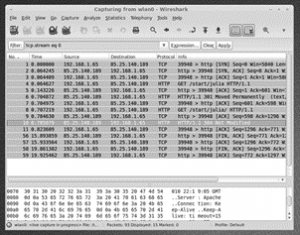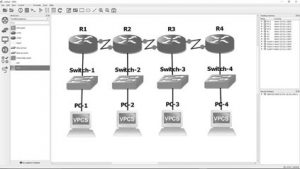For almost every industrial and military application, there is the need of computer and communication networks and the requirement of these is progressing day-by-day. With these networks, one can expect enhanced service with perfect functional conditions. It is more crucial to know the network performance where it is used. Simulation is employed to demonstrate the final and exact outputs and activities of courses. As the network simulation has multiple advantages and applications, this article shows a clear description of knowing what is meant by network simulation, various types of simulators, and its advantages.
What is Network Simulation?
In the extensive investigation of computer networks, one of the most important methodology to know is network simulation. It is the process a software-defined program shapes the behavior of the network by measuring the relation between various activities such as access nodes, routers, links, switches, and others. Many of the simulators employ multiple event simulations where means the forming of systems where the state variables get varied at different points. The performance of the network system and the multiple applications and activities it handles can be known through the test experiment. It is even used to analyze the performance of protocols under multiple conditions.
Network Simulator
A network simulator is considered as the software which forecasts the performance of a computer network. By using conventional analytical approaches, it becomes complicated to know the exact functionality of the system, and to reduce the complexity, network simulators are employed. In the network simulators, the computer system is designed using links, applications, devices, and others, and using these the performance is analyzed.
These devices are used as assistance for many latest and updated networks and methodologies that are in an application today like IoT, wireless local area networks, 5G internet, WSN wireless sensor systems, cognitive radio systems, mobile Adhoc networks, LTE and many others.
Simulations
Many of the industrial simulators are CLI simulated whereas few other simulators are GUI simulated. The network arrangement defines multiple activities such as a network (routers, access points, links, and nodes) and events like packet errors, information transmission, and others. The output results consist of network-related calculations, link metrics, and appliance metrics, and many more.
In addition, drill down corresponding to simulations trace records are also in availability. Trace records hold information of each and every information of packet and event that took place in the simulation and those are utilized for the evaluation.
Many of the network simulators employ a discrete type of event simulation where in this a sequence of pending events are accumulated and those are analyzed one by one. Of all the accumulated events, few are the triggering future events like the event which corresponds to the packet arrival at one node that triggers the arrival of the event at one node of the corresponding packet at the downstream node.
Network Emulation
Through the network emulation, users will be introduced to real tools and applications internal to the testing simulated network which changes the flow of packets in a manner that simulates the performance of the live network. Live traffic can move over the simulator and it gets impacted by the objects those are internal to the simulation.
The conventional approach is that actual packets in the live application will be transmitted to the emulation server (Emulation server means simulation point of the virtual network). These actual packets will be modulated and they will be formed as simulation packets.
The simulation packet undergoes demodulation and forms into an actual packet when it is subjected to impacts of loss, jitter, delay in jitters, errors, and others thus transferring these network impacts into the actual packet. And this is the process when the actual packet is passed from the actual network whereas in the realistic conditions it will be passed across the network that is simulated. Network emulation is extensively employed in designing phases in order to validate communication networks in before they move to the deployment stage.
Network Simulation Tools
Through network simulation tools, one can be able to transform their thoughts into real outcomes. These tools are not just used for modeling, they also imitate the performance of the network in the real scenario. It can also be termed that using a network simulation is not economical and also they analyze the thought in the real-time environment. With this, there are many types of network simulation available Few those are:
Graphical Network Simulator 3 – NS3
The GNS3 is a tool and also software which is a type of virtual network that comes in a suitcase. This tool can be able to simulate the complicated network and related cases and stands and helps with the combination of real and virtual network components. This is the widely used software so as to develop, frame, set up, and test the network conditions in a totally risk-free virtual atmosphere. This tool can be used in windows, Linux, and Mac operating systems.
Secure CRT
This tool shows the ability to form an SSH connection having a dynamic port forwarding arrangement which can be employed as a SOCKS proxy in order to be in reach with all the systems that are working in a remote network (which means behind the gateway). Through the SSH connection, any application can be either SOCKS 4 or 5 (along with the other sessions that are formed with Secure CRT). The SOCKS 4 or 5 holds the ability to have their SSH connections forwarded from the SSH SOCKS proxy and to the required target location.
WireShark
This is the easily accessible and free, open-source packet analyzing software. This was initiated by Gerald Combs in the year 1998. At present, this tool is the most extensively implemented network protocol tracker. This is employed for resolving network related problems, understanding, protocol augmentation, review, and education. Wireshark also provides the feature to know what the situation of the network at the infinitesimal level is.

Wireshark Network Simulation
Network Simulator 3
The NS3 is the network simulation tool that has a series of event network simulators mainly NS-1, NS-2, and NS-3. This tool is the discrete type of tool which is mainly targeted at networking exploration. It offers considerable assistance for TCP simulation, multicasting protocols across wireless and wired networks, and useful for routing too. This is externally available for development, utilization, and research.
These are the different network simulators. In addition, there are many other types of network simulation tools which are:
- OPNET
- Qualnet
- Netkit
- Java-based simulation
- Marionnet
Advantages of Network Simulators
These simulators offer an inexpensive approach for:
- Satellite communications
- In defense applications like high-frequency, ultra-high frequency, and very high frequencies and MANET radios and in tactical data links and in others
- They provide a practical response for the customers while developing real-world systems
- They offer system designers to observe trouble at multiple abstraction phases
Please refer to this link to know more about Wireless Sensor Network MCQs & Computer Networks MCQs
On the whole, this is about network simulation. Here, we have gone through the concepts of network simulation, different tools, network emulation, and its advantages. The one crucial question to be known is does C++ is a network simulator tool or not?
